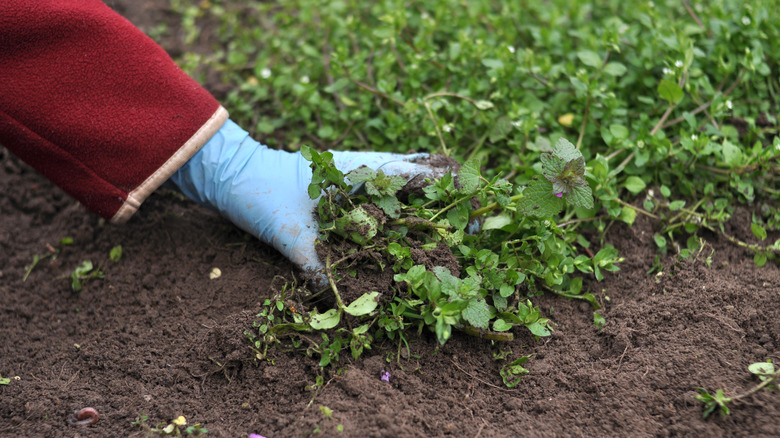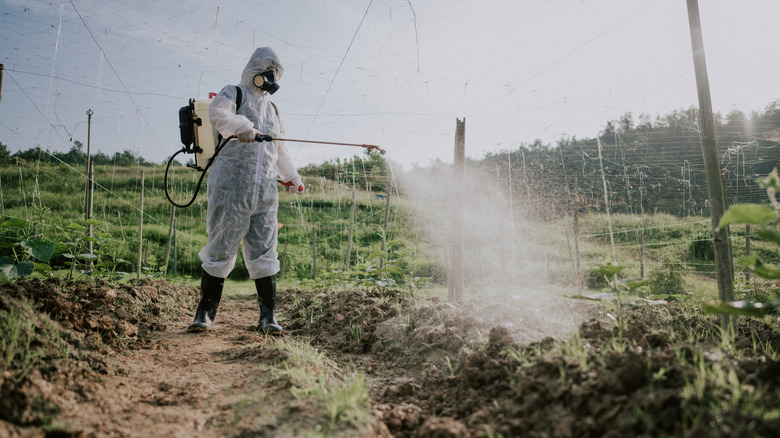How To Get Rid Of Daisies If They're Taking Over Your Yard
To reclaim your yard from an invasion of daisies, you have two main options: physically remove them or resort to weed killers. But before we dive into those methods, let's better understand what you're up against. Although there are many different types of daisies, most are perennials, meaning they can survive year-round. They also grow in a way that takes up more and more space over time. These persistent plants are highly adaptable, thriving in various soil types — sometimes even in soils too compacted for other plants to survive. Visually, daisies are pretty easy to identify. Typically, they have a central yellow disc with white or occasionally pinkish petals surrounding it. Their leaves are generally spoon-shaped and can form a sort of rosette at the base of the plant.
Daisies can grow anywhere from a few inches to a couple of feet tall, depending on the variety and conditions. Despite their charming appearance, they can be quite the aggressor in your garden. They are notorious for outcompeting your cultivated plants for water, space, and nutrients. Before you know it, these seemingly innocent flowers can overtake your lawn, undermining its health and aesthetics. By creating dense mats of foliage and producing seeds prolifically, daisies propagate easily, making them a formidable opponent. That's why, to preserve the health and beauty of your lawn or garden, getting rid of them requires decisive action.
Physical removal: the role of daisy grubbers and other tools
If you're up for some hands-on work, you can physically remove the plant with a daisy grubber. This specialized tool is ingeniously designed to slide under the root system of the daisy. With some leverage, you can pull out the entire plant—roots and all. Why is this so important? Eliminating the root is crucial to ensuring the plant doesn't make an unwelcome comeback, helping you effectively halt its spread across your lawn. But what if you don't have a daisy grubber or prefer a different approach? You can also take a sharp knife and slice through the dense mats of foliage. Commit to doing this once a week, and you'll notice the daisies starting to weaken and loosen up. Over time, this makes them much easier to pull out or dig up. Just remember, gathering all the lawn clippings is essential after you're done cutting or pulling. Those innocent-looking clippings can easily contribute to a new wave of daisy proliferation if left unattended.
As for daisies that have taken up residence in the border areas of your yard, the solution is even simpler. Pull them out by hand or dig them up using a small spade or garden fork. Though it demands more effort and regular monitoring, this manual method steers clear of chemical solutions. Plus, there's a sense of immediate gratification in reclaiming your lawn from these invasive plants.
Chemical solutions: systematic weed killers
If the idea of physical labor doesn't resonate with you, or if you're faced with a large-scale daisy invasion, chemical solutions may be a more suitable route. Specifically, a systematic weed killer applied directly to the daisy foliage can prove highly effective. This is especially true for those pesky daisies that have found their way into your paving or flowerbeds. These herbicides absorb into the plant and circulate throughout its entire system, effectively killing it from the inside out. The advantage here is that chemical solutions efficiently address widespread daisy issues. Yet, a word to the wise: always follow the manufacturer's guidelines when dealing with chemical solutions. Also, when applying the solution, precision is the name of the game here; aim carefully to target only the daisies. You don't want to mistakenly harm other plants or areas of your lawn you'd like to keep intact.
Adjusting your lawn care routine can also tip the scales in favor of your grass and against the daisies. One tactic is to set your mower deck a little higher than you normally would. By doing so, you encourage your grass to grow more horizontally than vertically. This growth pattern enables the grass to produce new leaves, making it more challenging for daisies to get the light they crave. Alongside this mowing strategy, consider applying a high-quality fertilizer to your grass. Well-fertilized grass is more robust and can outcompete daisies for essential nutrients and space.


